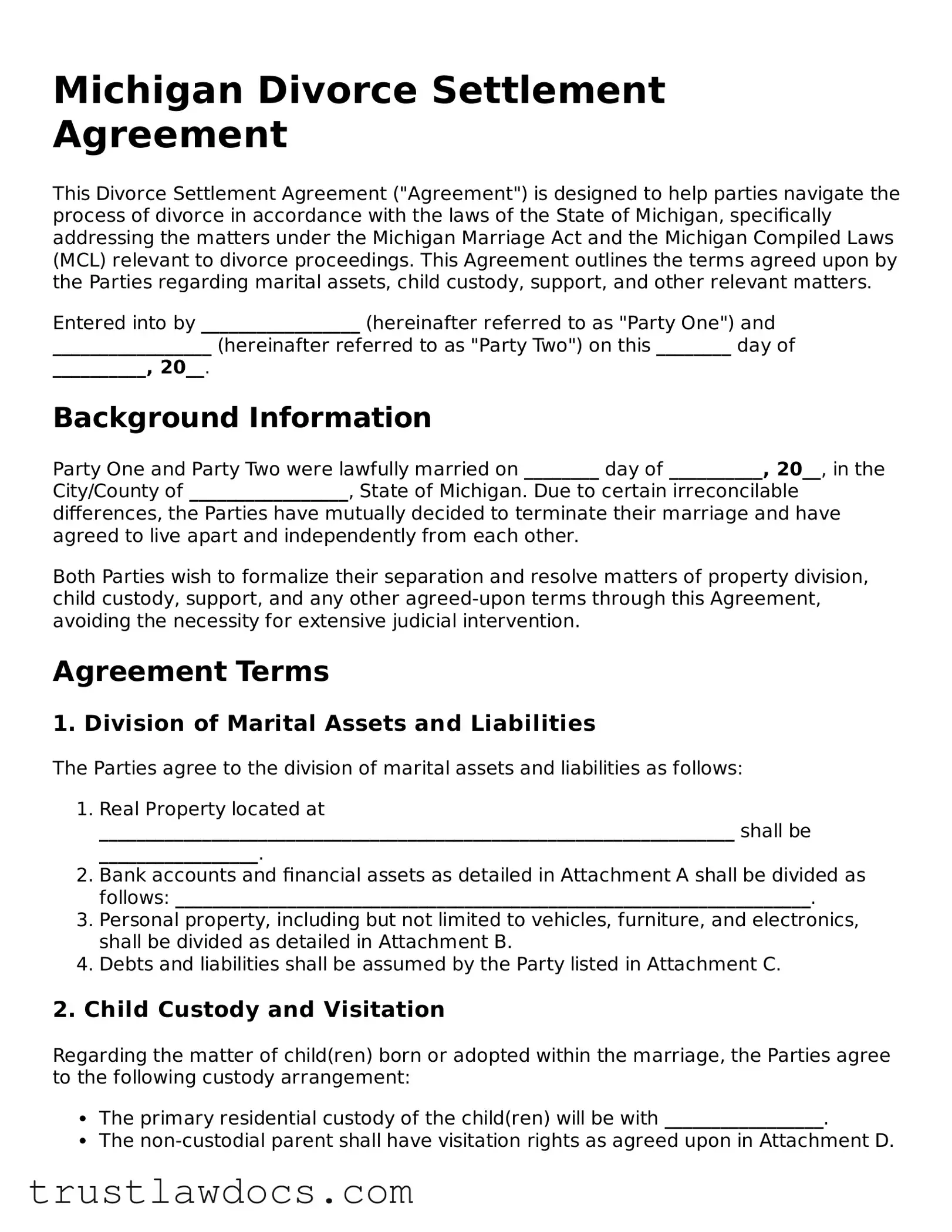Michigan Divorce Settlement Agreement
This Divorce Settlement Agreement ("Agreement") is designed to help parties navigate the process of divorce in accordance with the laws of the State of Michigan, specifically addressing the matters under the Michigan Marriage Act and the Michigan Compiled Laws (MCL) relevant to divorce proceedings. This Agreement outlines the terms agreed upon by the Parties regarding marital assets, child custody, support, and other relevant matters.
Entered into by _________________ (hereinafter referred to as "Party One") and _________________ (hereinafter referred to as "Party Two") on this ________ day of __________, 20__.
Background Information
Party One and Party Two were lawfully married on ________ day of __________, 20__, in the City/County of _________________, State of Michigan. Due to certain irreconcilable differences, the Parties have mutually decided to terminate their marriage and have agreed to live apart and independently from each other.
Both Parties wish to formalize their separation and resolve matters of property division, child custody, support, and any other agreed-upon terms through this Agreement, avoiding the necessity for extensive judicial intervention.
Agreement Terms
1. Division of Marital Assets and Liabilities
The Parties agree to the division of marital assets and liabilities as follows:
- Real Property located at ____________________________________________________________________ shall be _________________.
- Bank accounts and financial assets as detailed in Attachment A shall be divided as follows: ____________________________________________________________________.
- Personal property, including but not limited to vehicles, furniture, and electronics, shall be divided as detailed in Attachment B.
- Debts and liabilities shall be assumed by the Party listed in Attachment C.
2. Child Custody and Visitation
Regarding the matter of child(ren) born or adopted within the marriage, the Parties agree to the following custody arrangement:
- The primary residential custody of the child(ren) will be with _________________.
- The non-custodial parent shall have visitation rights as agreed upon in Attachment D.
- Both Parties agree to adhere to the child custody and visitation schedule outlined, promoting the welfare and best interests of the child(ren).
3. Child Support and Expenses
Consistent with Michigan laws, the non-custodial parent will provide child support in the amount of ________ per month, subject to review and modification by the court. Additionally, both Parties will share any extraordinary medical, educational, or recreational expenses, as detailed in Attachment E.
4. Spousal Support
The Parties have agreed upon spousal support arrangements as follows: _________________. This arrangement reflects consideration of the length of the marriage, each party's financial status, and other factors deemed relevant by the Parties.
5. Miscellaneous Terms
Any future disputes stemming from this Agreement shall be mediated before any court action is taken, in an effort to amicably resolve such disputes without court intervention. Each Party shall bear their own legal costs unless otherwise stated in this Agreement.
Final Acknowledgment
By signing below, Party One and Party Two acknowledge they have read and understood this Agreement, entering into it voluntarily. This Agreement represents a full and complete understanding and settlement concerning the terms of their divorce.
Signature of Party One: _________________ Date: ________
Signature of Party Two: _________________ Date: ________
This document is not a substitute for legal advice or services. Consult with a Michigan licensed attorney for advice on any legal matter.
